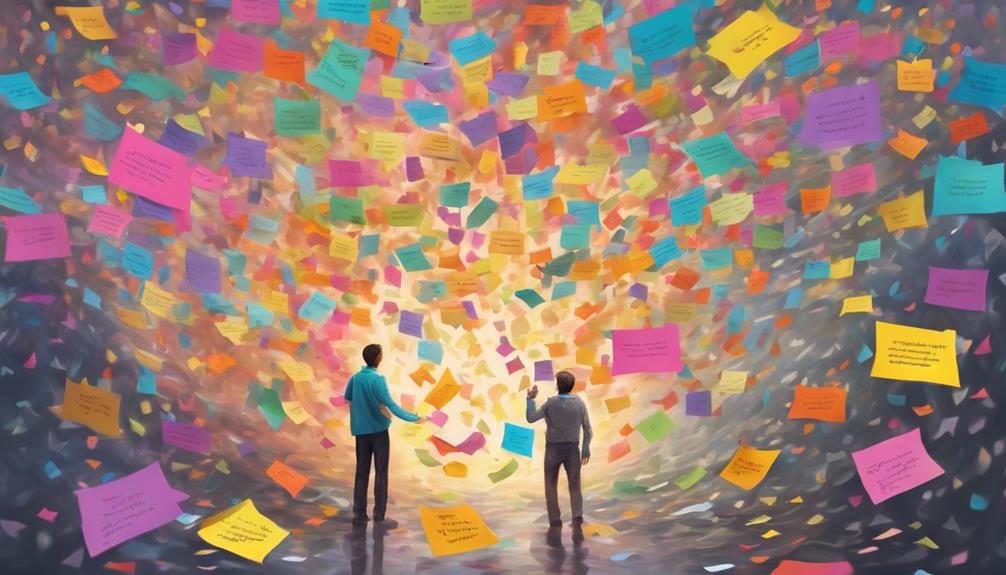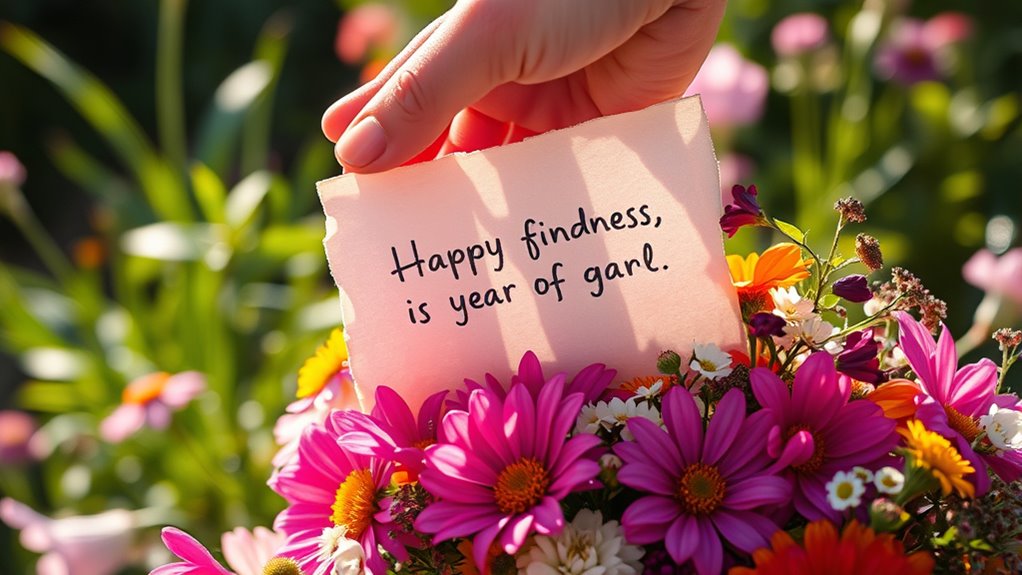Boost your goal achievement with wish notes, clarifying your aims and mapping out your path to success. By vividly describing your goals in wish notes, you elevate your success rates considerably. These notes serve as a practical roadmap, focusing your efforts and accelerating your progress towards your dreams. Taking responsibility for overcoming obstacles aids in prioritizing goals effectively. Professional support can enhance your skills and provide valuable insights. Embrace hard work, dedication, and celebrate small wins to motivate yourself. Utilize wish notes as visual reminders, keeping you on track. Harness the power of wish notes to achieve your goals faster!
Key Takeaways
- Wish notes provide a clear roadmap for goal achievement.
- They enhance focus on a single goal, accelerating progress.
- Acting as visual reminders, wish notes maintain dedication.
- Wish notes help prioritize goals effectively, boosting success.
- They serve as practical tools to transform dreams into achievements.
Enhancing Goal Clarity

Enhance your goal clarity with the powerful tool of wish notes, vividly describing what you aim to achieve. By setting clear goals and detailing them in wish notes, you're more likely to succeed. Research shows that writing down wishes in detail can increase success rates by 1.2 to 1.4 times.
These wish notes act as a practical roadmap, guiding you on the journey of transforming your dreams into tangible achievements. When your wishes are crystal clear, it helps you focus on a single goal, accelerating your progress and boosting productivity.
Setting goals and pursuing them with the aid of wish notes can make a significant difference in achieving your desired outcomes. These notes serve as a beacon, illuminating the path ahead and providing you with a clear vision of where you want to go.
Overcoming Obstacles With Responsibility

To achieve your goals effectively, it's essential to take ownership of overcoming obstacles with a sense of responsibility. One thing that often hinders progress is the presence of competing priorities. When faced with multiple tasks or distractions, it's vital to prioritize what you actually want to achieve.
Successful individuals like Oprah Winfrey and Walt Disney exemplify how taking responsibility for outcomes empowers individuals to drive success. Belief in your personal capability is key to overcoming setbacks and challenges, shaping the mindset needed for goal achievement.
Avoid fostering a victim mentality through complaints and excuses, as this hinders progress. Instead, embrace responsibility as it plays a pivotal role in personal development and goal attainment. By acknowledging your role in overcoming obstacles, you can navigate challenges more effectively and stay focused on your path to success.
Seeking Professional Support

Investing in professional support, such as mentorship and training, can greatly boost your skill development and accelerate your progress towards achieving your goals. Seeking guidance from experts in your field is an important thing to contemplate when moving towards success. Here are some reasons why seeking professional support can help you reach your goals faster:
- Gain valuable insights:
Professionals can provide you with valuable insights and perspectives that you may not have pondered on your own.
- Receive tailored advice:
Personalized advice from professionals can help you navigate challenges more effectively.
- Access to resources:
Professional support often comes with access to resources and tools that can enhance your learning and development.
- Accountability:
Working with professionals can help you stay accountable to your goals and feel less overwhelmed by the journey.
- Boost confidence:
With the guidance of professionals, you can feel more confident in your abilities and decisions, propelling you towards success.
Embracing Hard Work and Dedication

You know that achieving your goals faster requires embracing hard work and dedication.
By persistently putting in the effort and staying motivated, you set yourself up for success.
Committing to your goals with unwavering dedication is the key to making significant progress.
Persistence and Consistency
Embracing hard work and dedication is vital to achieving your goals faster and more effectively. Persistence and consistency play a pivotal role in propelling you towards success. By staying dedicated to your goals and consistently putting in the effort, you increase your chances of accomplishing them by 1.2 to 1.4 times.
Here are some essential tips to help you embrace persistence and consistency on your journey:
- Prioritize your goals and allocate time and energy accordingly.
- Break down your goals into manageable tasks to maintain momentum.
- Stay committed to your goals even when faced with challenges or setbacks.
- Celebrate small victories along the way to stay motivated and focused.
- Learn from successful individuals like Oprah and Walt Disney, who exemplify the power of dedication in achieving remarkable milestones.
Motivation and Focus
Boosting motivation and maintaining focus are key components in embracing hard work and dedication towards achieving your goals faster. Wish notes play an essential role in this process by serving as constant visual reminders of your goals.
By keeping your aspirations at the forefront of your mind, wish notes help you stay focused on what you want to achieve. This continuous reinforcement of your objectives encourages you to put in the necessary hard work and dedication required for success.
Research indicates that visual cues, like wish notes, can significantly boost persistence in pursuing your goals. These notes act as motivators that push you to keep moving forward, even when faced with challenges or setbacks.
Commitment to Success
To accomplish success, maintaining a strong commitment to hard work and dedication is vital. Embracing hard work and dedication accelerates goal achievement by helping you stay focused and consistent.
Success often demands continuous effort and dedication to overcome obstacles and challenges that may arise along the way. Prioritizing your goals over distractions is critical for staying on track and making meaningful progress towards success.
It's important to strike a balance between work and self-care to guarantee you can sustain your long-term dedication to achieving your goals. Consistent hard work and dedication are key factors that drive progress towards your desired outcomes.
Utilizing Business Investment Strategies

Investing in strategic business tools and software can greatly enhance operational efficiency and productivity.
By utilizing cost-effective marketing strategies like social media and content marketing, you can significantly boost your business's visibility and engagement levels.
Additionally, investing in budget-friendly tools and software can streamline your business processes, leading to improved overall efficiency.
Collaborating with other businesses for mutually beneficial partnerships is another wise investment strategy that can expand your network and open up new opportunities for growth.
Attending networking events and industry conferences is also important as it helps you build valuable connections and stay updated on the latest industry trends.
Lastly, focusing on improving your skills through complimentary online courses and resources can enhance your expertise, making you more competitive in the market.
Implementing Procrastination Management Tactics

If you struggle with procrastination, it's time to address the root causes and implement effective management strategies.
By identifying what triggers your procrastination and finding ways to combat it, you can enhance your productivity and achieve your goals faster.
Take proactive steps to manage your time, prioritize tasks, and stay focused to overcome procrastination tendencies.
Procrastination Root Causes
Understanding the root causes of procrastination is essential for effectively implementing management tactics to combat it. Procrastination can stem from various underlying issues that need to be addressed to overcome this common hurdle.
Here are some key factors that contribute to procrastination:
- Fear of failure
- Perfectionism
- Lack of self-awareness
- Poor time management skills
- Anxiety and lack of motivation
Effective Management Strategies
Implementing effective management strategies to combat procrastination is vital in enhancing productivity and achieving goals efficiently.
Procrastination management tactics play a pivotal role in overcoming delays that hinder your progress. Strategies tailored to address anxiety-induced procrastination can greatly boost your efficiency in goal pursuit.
Delving into books focused on procrastination offers valuable insights and practical techniques to break free from the cycle of delay.
Productive procrastination, when utilized wisely, can serve as a valuable tool to tackle tasks promptly. By recognizing how perfectionism contributes to procrastination, you can take steps to break this pattern and move closer to your objectives.
Embracing these proactive approaches empowers you to navigate procrastination hurdles effectively and make meaningful strides towards achieving your aspirations.
Prioritizing the implementation of these strategies will undeniably propel you towards success in a more timely and structured manner.
Balancing Work-Life Priorities

To achieve a healthy work-life balance, it's essential to prioritize family time and self-care alongside your work commitments. Balancing these aspects can lead to reduced stress levels and an overall improvement in well-being.
Here are some key strategies to help you achieve a harmonious equilibrium between your professional and personal life:
- Effective Time Management: Utilize tools and techniques to manage your time efficiently, ensuring you can fulfill both work and personal responsibilities.
- Setting Boundaries: Establish clear boundaries between work and personal time to prevent one from encroaching on the other.
- Learning to Say No: Understand when to decline additional work or commitments to avoid overloading yourself.
- Regular Self-Assessment: Take time to assess your priorities and make adjustments as needed to maintain a balanced lifestyle.
- Prioritizing Self-Care: Make time for activities that promote self-care and relaxation to recharge and stay healthy physically and mentally.
Mastering Mindset and Self-Improvement

Track your mindset and progress consistently to navigate your learning journey effectively.
Share your experiences with others for valuable insights and enhanced self-improvement.
Embrace failures as stepping stones and cultivate a resilient mindset for growth.
Mindset Tracking Methods
Utilizing effective mindset tracking methods is crucial for mastering your mindset and achieving self-improvement goals at a faster pace. Tracking mindsets and making notes can increase self-awareness, guiding you towards a path of personal development.
Being conscious of learning experiences enables you to pinpoint areas for growth and improvement, propelling you closer to your desired outcomes. Sharing experiences with others offers valuable insights and diverse perspectives that can greatly contribute to your journey of self-improvement.
Embracing failures and frustrations as learning opportunities nurtures resilience and fosters personal growth, shaping you into a stronger version of yourself. In addition, keeping track of your progress through mindset tracking methods not only serves as a constant source of motivation to propel you forward towards your goals but also maintains accountability.
Embracing Failures Positively
Embracing failures positively is an essential mindset shift for accelerating your personal growth and achieving your goals faster. When you view setbacks as learning opportunities, you gain valuable insights that can propel you forward. Successful individuals often credit their achievements to how they navigated through failures and setbacks.
By embracing failures positively, you cultivate resilience, determination, and a growth mindset that are pivotal for personal development. Instead of being deterred by failures, see them as stepping stones towards success. Each misstep is a chance for self-improvement and growth.
Crafting Effective Action Plans

To create effective action plans for achieving your goals faster, it's essential to carefully outline specific steps and strategies.
Here are some key tips to help you craft action plans that propel you towards success:
- Break Down Goals: Divide your main goal into smaller, manageable tasks to make progress more achievable.
- Set Deadlines: Assign realistic deadlines to each task to maintain momentum and hold yourself accountable.
- Track Progress: Regularly monitor your advancement towards your goals to stay motivated and adjust strategies if needed.
- Identify Resources: Determine what tools, skills, or support you need to accomplish each task effectively.
- Plan for Challenges: Anticipate potential obstacles and develop strategies to overcome them, ensuring smoother progress towards your ultimate goal.
Leveraging Effort-Reward Dynamics

How can you effectively harness the power of effort-reward dynamics to propel yourself towards achieving your goals faster?
Understanding the balance between the effort you put in and the rewards you expect is key to accelerating your progress. By aligning your efforts with the rewards you desire, you can boost your motivation and maintain momentum in pursuing your goals.
Wish notes play a significant role in this process by serving as tangible reminders of the rewards that await you once you achieve your goals. When you leverage wish notes effectively, you can stay focused on your efforts by visualizing the rewards you're working towards. This visualization not only keeps you motivated but also reinforces the connection between your actions and the outcomes you seek.
Frequently Asked Questions
How Can Writing Help You Achieve Your Goals?
Writing aids goal achievement by enhancing memory retention and focus. It increases success rates substantially, as writing down goals improves recall and encoding. Make it a habit to vividly jot down your goals for better results.
What Is the Fastest Way to Achieve Your Goal?
To achieve your goal fastest, set a clear target, break it into manageable steps, create a timeline, stay focused, and track progress. Consistent effort, adaptability, and learning from setbacks will propel you forward efficiently.
Does Writing Down Goals Help You Achieve Them?
Writing down goals boosts success rates by 1.2 to 1.4 times. When you write your goals, you enhance memory retention, increase reprocessing of mental images, and improve goal achievement. Don't underestimate the power of writing!
How Do You Wish to Reach Your Goals in Life?
You wish to reach your goals in life by setting clear objectives, developing a plan of action, staying focused, and taking consistent steps towards your aspirations. Visualizing success and staying motivated will propel you forward.
Conclusion
By utilizing wish notes to enhance goal clarity, overcome obstacles, seek support, and master mindset, you can achieve your goals faster than ever before. To make the most of wish notes, it’s important to regularly revisit and update them based on your progress and any changes in your goals. Additionally, consider using wish note writing tips such as being specific and detailed, using positive language, and setting realistic timelines for your goals. By incorporating these strategies into your wish note practice, you can maximize their effectiveness in achieving your desired outcomes.
With dedication, hard work, and effective action plans, success becomes not just a dream, but a reality.
Don't just wish for your goals to happen, make them happen with the power of wish notes.
Start taking action today and watch your dreams come true!









